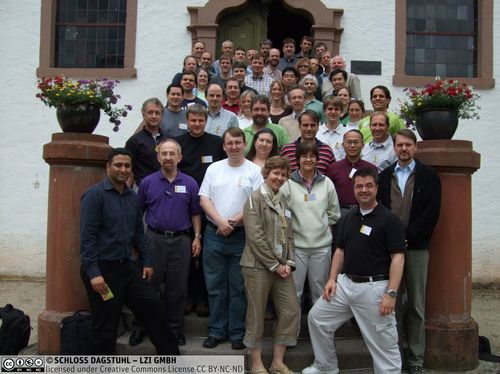Dagstuhl-Seminar 08231
Virtual Realities
( 01. Jun – 06. Jun, 2008 )
Permalink
Organisatoren
- Guido Brunnett (TU Chemnitz, DE)
- Sabine Coquillart (INRIA - Grenoble, FR)
- Gregory F. Welch (University of North Carolina at Chapel Hill, US)
Kontakt
Impacts
- Reflections on the Design and Implementation of Virtual Environments Systems : Special Issue : S. III-IV, 83-195 - Steed, Anthony; Reiners, Dirk; Latoschik, Marc Erich - Cambridge : MIT Press, 2010 - (Presence : 19. 2010, 2).
- Virtual Realities : Dagstuhl Seminar 2008 - Coquillart, Sabine; Brunnett, Guido; Welch, Greg - Berlin : Springer, 2011. - XIII, 251 S.. ISBN: 978-3-211-99177-0 / 3-211-99177-8.
Press Reviews
-
Virtuelle Welten können vielleicht einmal real werden
Interview Wolfgang Back vom Computerclub Zwei mit Prof. Dr. Guido Brunnett (Technische Universität Chemnitz); Folge 115, 30.06.08 - Download der Sendung 115, 32 Kbit/s (~7 MB)
Virtual Reality (VR) is a multidisciplinary area of research aimed at interactive human-computer mediated simulations of artificial environments. Typical applications include simulation, training, scientific visualization, and entertainment. An important aspect of VR-based systems is the stimulation of the human senses—typically sight, sound, and touch—such that a user feels a sense of presence (or immersion) in the virtual environment. Different applications require different levels of presence, with corresponding levels of realism, sensory immersion, and spatiotemporal interactive fidelity.
To improve the sense of immersion, developers typically build multi-modal systems, i.e. systems that stimulate multiple human senses. The development of appropriate multi-modal devices (projection walls, head mounted displays, data gloves, force feedback arms, spatialized audio, etc.) to deliver multi-modal signals into the human sensory system is a basic aspect of VR technology. The fidelity and degree of immersion of these systems is a crucial factor in any user-perceived sense of presence.
In addition, the impression that can be achieved is limited by the richness of the model that describes the virtual environment. As such, another crucial aspect is VR modelling. The scope of VR modelling typically goes beyond conventional (e.g. geometric) modelling in that it often integrates aspects related to the different modalities, for example visual, acoustic, or haptic characteristics.
If the environment includes dynamic objects, the movements of these objects must also be described. However, in contrast to conventional simulation, updates to the dynamic objects have to be computed in real time. To achieve high performance, today’s VR systems often include some form of parallel processing of the simulation data. If compromises between the competing requirements of realistic behaviour and performance have to be made, human factors are taken into consideration.
Finally, a key ingredient of any VR system is the interaction between the human and the computer. For a sense of presence to be sustained, it is necessary that the objects of the virtual world appropriately react to the actions of the user. Some primary challenges in this context include the real-time tracking of the user’s movements, and the design of intuitive devices for the user to control the virtual environment. In particular, many problems remain in the realization of VR systems that simultaneously support multiple users.
- Gudrun Albrecht (University of Valenciennes, FR) [dblp]
- Carlos Andujar (UPC - Barcelona, ES) [dblp]
- Steffi Beckhaus (Universität Hamburg, DE) [dblp]
- Mark Billinghurst (University of Canterbury - Christchurch, NZ) [dblp]
- Roland Blach (FhG IAO - Stuttgart, DE) [dblp]
- Wolfgang Broll (Fraunhofer Institut FIT - St. Augustin, DE) [dblp]
- Guido Brunnett (TU Chemnitz, DE) [dblp]
- Sabine Coquillart (INRIA - Grenoble, FR) [dblp]
- Carolina Cruz-Neira (LITE - Lafayette, US) [dblp]
- Ralf Dörner (Hochschule RheinMain, DE) [dblp]
- Steven K. Feiner (Columbia University, US) [dblp]
- Dieter W. Fellner (TU Darmstadt, DE) [dblp]
- Jan-Michael Frahm (University of North Carolina at Chapel Hill, US) [dblp]
- Bernd Fröhlich (Bauhaus-Universität Weimar, DE) [dblp]
- Henry Fuchs (University of North Carolina at Chapel Hill, US) [dblp]
- Hans Hagen (TU Kaiserslautern, DE) [dblp]
- Tobias Höllerer (University of California - Santa Barbara, US) [dblp]
- Roger Hubbold (University of Manchester, GB)
- Victoria Interrante (University of Minnesota - Minneapolis, US) [dblp]
- Heather Jenkin (York University - Toronto, CA)
- Michael R. M. Jenkin (York University - Toronto, CA)
- Bernhard Jung (TU Bergakademie Freiberg, DE) [dblp]
- Yoshifumi Kitamura (Osaka University, JP) [dblp]
- Gudrun Klinker (TU München, DE) [dblp]
- Torsten Kuhlen (RWTH Aachen, DE) [dblp]
- Marc Erich Latoschik (Universität Bielefeld, DE) [dblp]
- Robert W. Lindeman (Worcester Polytechnic Institute, US) [dblp]
- Benjamin C. Lok (University of Florida - Gainesville, US) [dblp]
- Mark Mine (Walt Disney Imagineering, US) [dblp]
- Betty Mohler (MPI für biologische Kybernetik - Tübingen, DE) [dblp]
- Stefan Müller (Universität Koblenz-Landau, DE)
- Stephan Olbrich (Universität Düsseldorf, DE)
- Ramesh Raskar (MIT - Cambridge, US) [dblp]
- Dirk Reiners (LITE - Lafayette, US) [dblp]
- Simon Richir (ENSAM Presence & Innovation Laboratory - Laval, FR)
- Bodo Rosenhahn (Leibniz Universität Hannover, DE) [dblp]
- Makoto Sato (Tokyo Inst. of Technology, JP)
- Dieter Schmalstieg (TU Graz, AT) [dblp]
- Andreas Simon (FH Nordwestschweiz, CH) [dblp]
- Mel Slater (UPC - Barcelona, ES) [dblp]
- Oliver Staadt (Universität Rostock, DE) [dblp]
- Anthony Steed (University College London, GB) [dblp]
- Wolfgang Stuerzlinger (York University - Toronto, CA) [dblp]
- Haruo Takemura (Osaka University, JP)
- Robert van Liere (CWI - Amsterdam, NL) [dblp]
- Andreas Weber (Universität Bonn, DE) [dblp]
- Gregory F. Welch (University of North Carolina at Chapel Hill, US) [dblp]
- Mary C. Whitton (University of North Carolina at Chapel Hill, US) [dblp]
- Gabriel Zachmann (TU Clausthal, DE) [dblp]
Verwandte Seminare
- Dagstuhl-Seminar 13241: Virtual Realities (2013-06-09 - 2013-06-14) (Details)
Klassifikation
- computer graphics / computer vision
Schlagworte
- Motion Analysis
- Statistical Methods
- Computational Geometry


